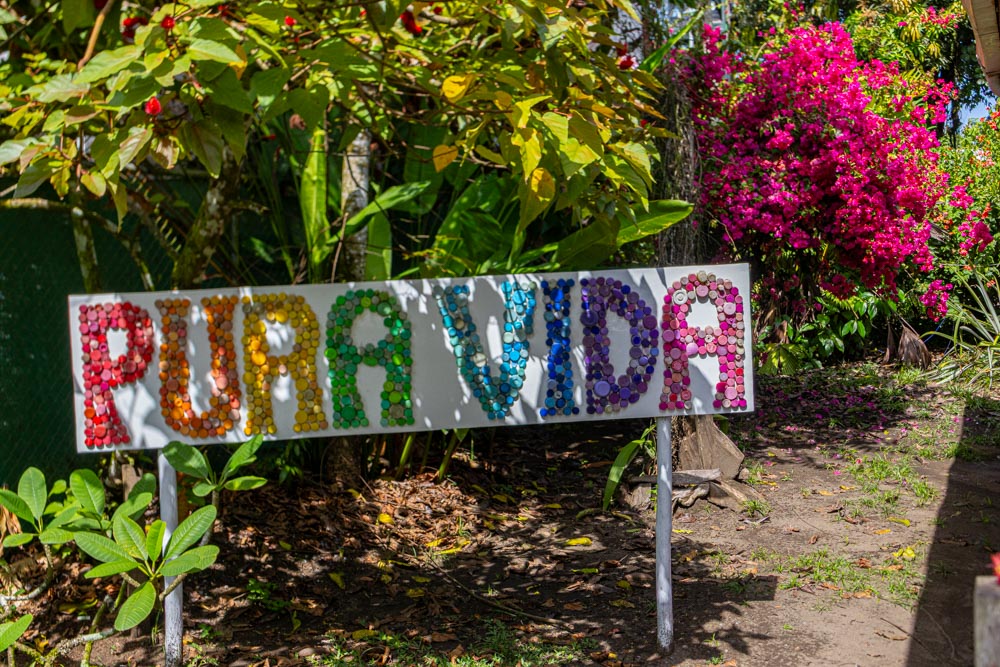
Our first visit to Costa Rica was a delayed honeymoon that had been in our thoughts for some time, however I felt guilt about going. Guilt because it felt strange to be in that part of the world, only within a few hours flying time to the United States to see my family and friends. When we attempted traveling in 2024, I suggested adding a flight to Oklahoma, followed by Iowa, equivalating to five or six additional planes, and we thus decided to forego Costa Rica.
I was also nervous. Nervous due to my irrational fear of falling from the sky in plane. Nervous about the heat on my pasty, freckly skin. Nervous about banana-baked and avocado – covered everything (allergies). Nervous about the insects. Nervous about being nervous, wondering to myself if maybe I was wondering too much?
Costa Rica seemed to be the much-needed remedy for anxiety-induced travelers with its national slogan and, more broadly, positive outlook on life: Pura Vida, an expression used to greet others and to give thanks. A part of pura vida is in reconnecting with the earth. Costa Rica is king when it comes to eco-tourism and slow travel- a getaway that yes, allows travelers to get out of their comfort zone, but also provides a sense of calm and nourishment for the soul.
- Day 1: Arrival in San José
- Day 2: Transfer from San José to Tortuguero
- Day 3: Tortuguero
- Days 4, 5 & 6: La Fortuna
- Days 7 & 8: Monteverde
- Days 9 & 10: Sámara
- Days 11 & 12: Cabuya – Montezuma
- Day 13: Manuel Antonio
- Day 14: Return to San José
Day 1: Arrival in San José


After an 11-hour flight, we touched down to a fiery sunset—the most vibrant I had ever seen. The air was thick with humidity, a blend of a midwestern summer and dusty attic, leaving a grimy residue on my hands, similar to the feeling of returning indoors after recess.
From Juan Santamaría International Airport we easily found an electric taxi service, Viaje Verde, taking us 6 km to our hotel, Guacima Escondida Hotel Boutique. While opened two months ahead of COVID-19 lockdown, the five rooms at Guacima Escondida are today nearly always booked.
Our taxi driver turned on the radio station and Queen’s “Don’t Stop Me Now” blasted through the speakers.
“We traveled halfway around the world to listen to the same songs,” my husband Laurent said.
Day 2: Transfer from San José to Tortuguero
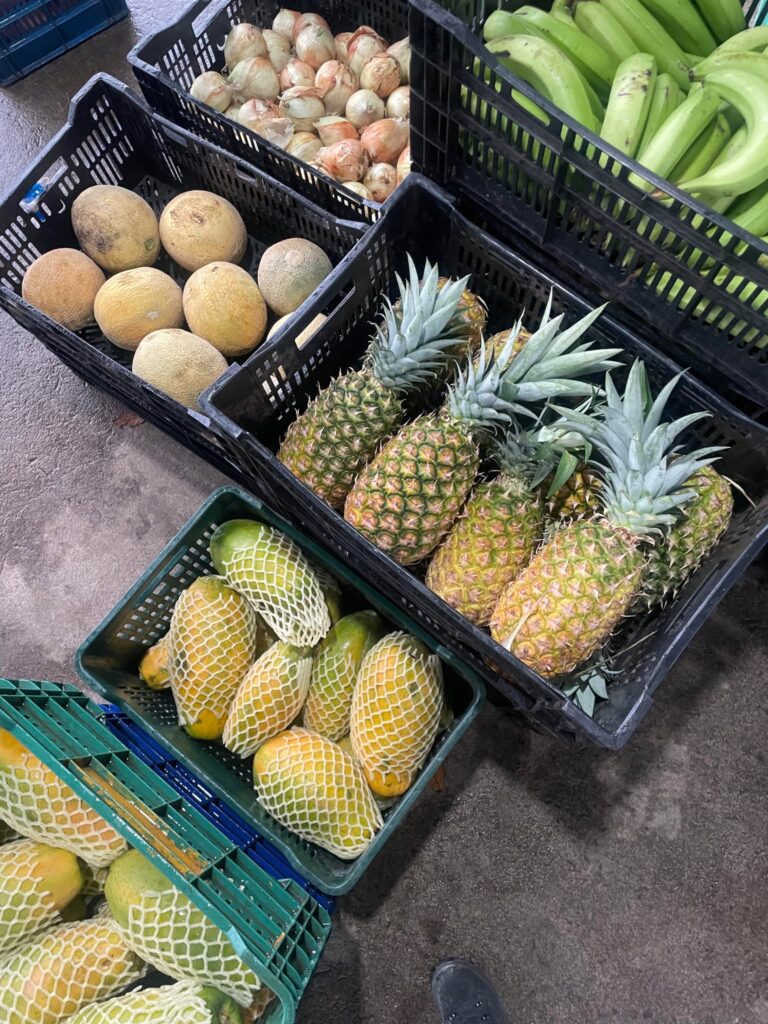
I woke up in the morning to the sounds of Motmots, turquoise-tailed backyard birds. We ate fresh papaya and pineapple from the garden, some of Costa Rica’s main exports, washed down with café con leche.
We sat out for a two-hour drive to Costa Rica’s Caribbean coast. In the distance we noticed the sky becoming darker, signaling rain ahead and entrance into the country’s cloud forest. The misty haze suddenly took over the road before us, outlined only by the lush greenery and large leaves known in Spanish as the “poor man’s umbrella”, grown in high altitudes. We crossed over a bridge and saw a river turned mustard yellow due to sulfur in a nearby volcano.
Making our descent from the clouds, we noticed a few side road accidents, with pickup trucks known locally as vultures, rushing to be the first to collect broken vehicles in exchange for cash. We stopped at a rest stop that seemed popular on Sunday morning with families seated at wooden tables, walls decorated with bunches of bananas picked from nearby plantations. We gobbled tortillas with cheese and sipped on our second café con leche.
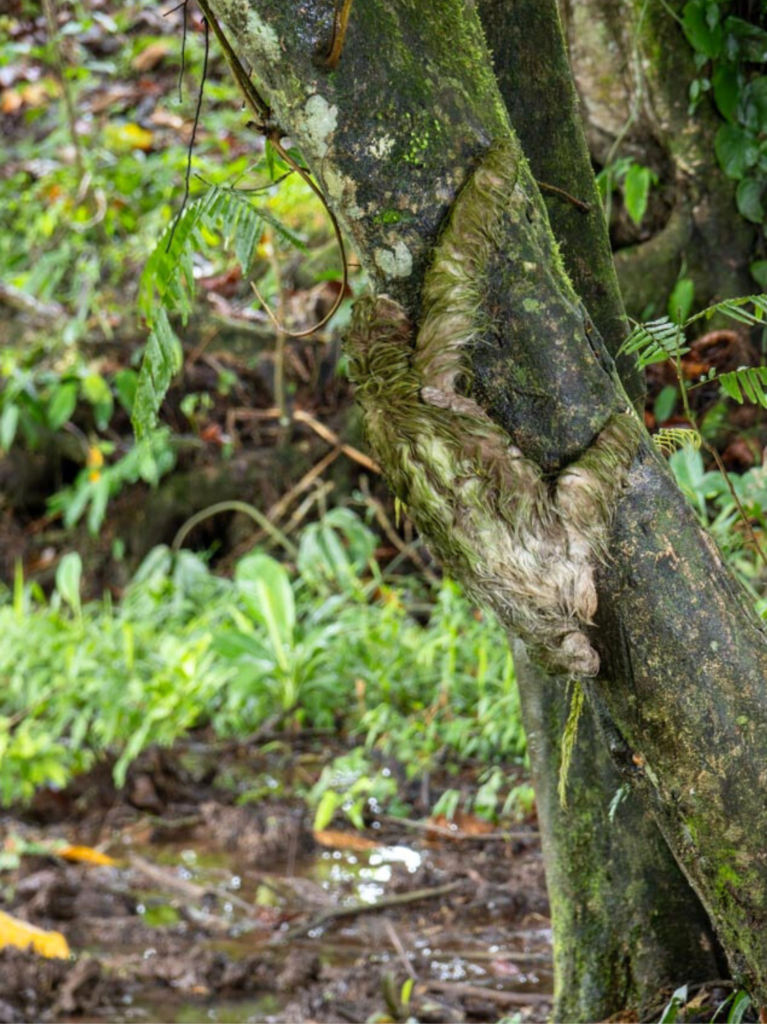
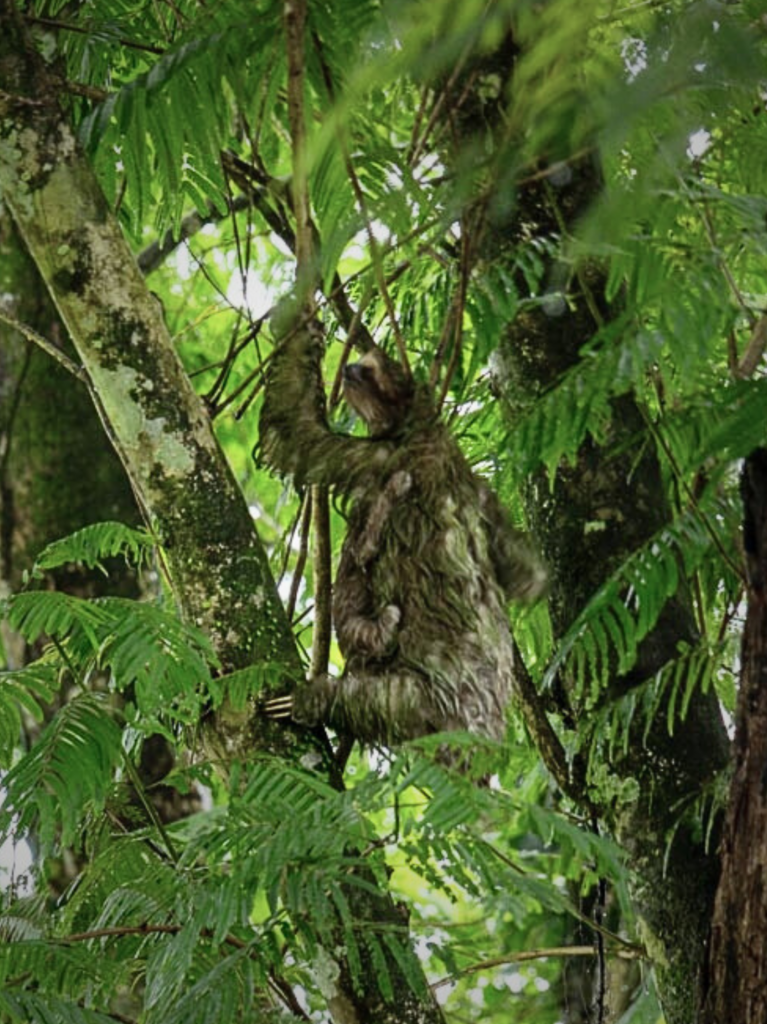
When asking about the local culinary specialties, we were informed that a typical Costa Rican breakfast consists of hearty Gallo Pinto, or mixed beans and rice. For lunch, we could order Casado, which is also beans and rice, only mixed.
Following our second breakfast of the day, we headed back on the road. A vehicle was stopped ahead, with a woman outside filming something on her phone. “Sloth,” she whispered to us as we pulled over to see our first sloth sighting in Costa Rica. Unlike most sloths found high up in the treetops, this algae-covered sloth (of which whose fur is an ecosystem within itself as it nourishes insects), was making it way to a tree trunk from the muddy ground. As it turned towards us, we noticed that it was carrying a baby clasped around its neck.

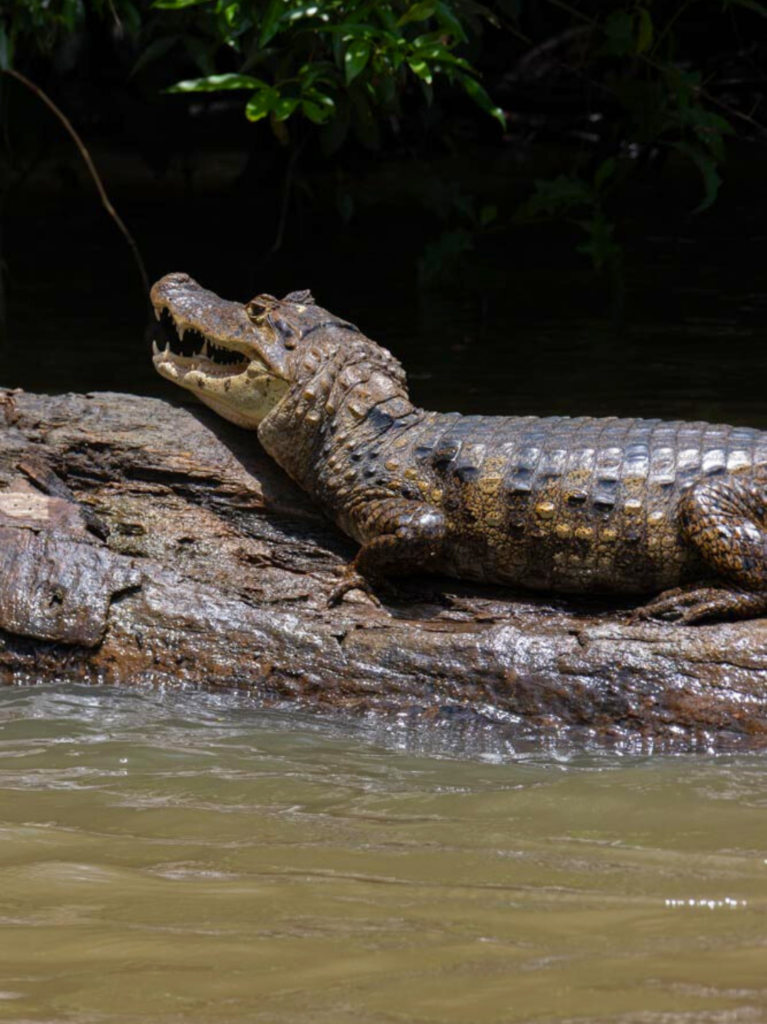
Besides hosting of the world’s most biodiverse forest, a part of the charm of journeying to Tortuguero is that it can only be reached by boat. Travelers can park their vehicles at La Pavona, which is equipped with restrooms and a snacking area and where by 11:00 a.m. we had our third café con leche of the day. We joined a herd of North Face wearing, poncho sporting, Birkenstock clad tourists to a series of boats aligned along the muddy river, as barefoot boys shuffled overpacked suitcases aboard.
While not a guided tour, the boat ride to Tortuguero is an adventure in its own right- during which we crossed paths with large crocodiles and several lizards seeking sun upon the sandy riverbanks. A journey that typically takes 40 minutes took us two hours due to three weeks without rain.
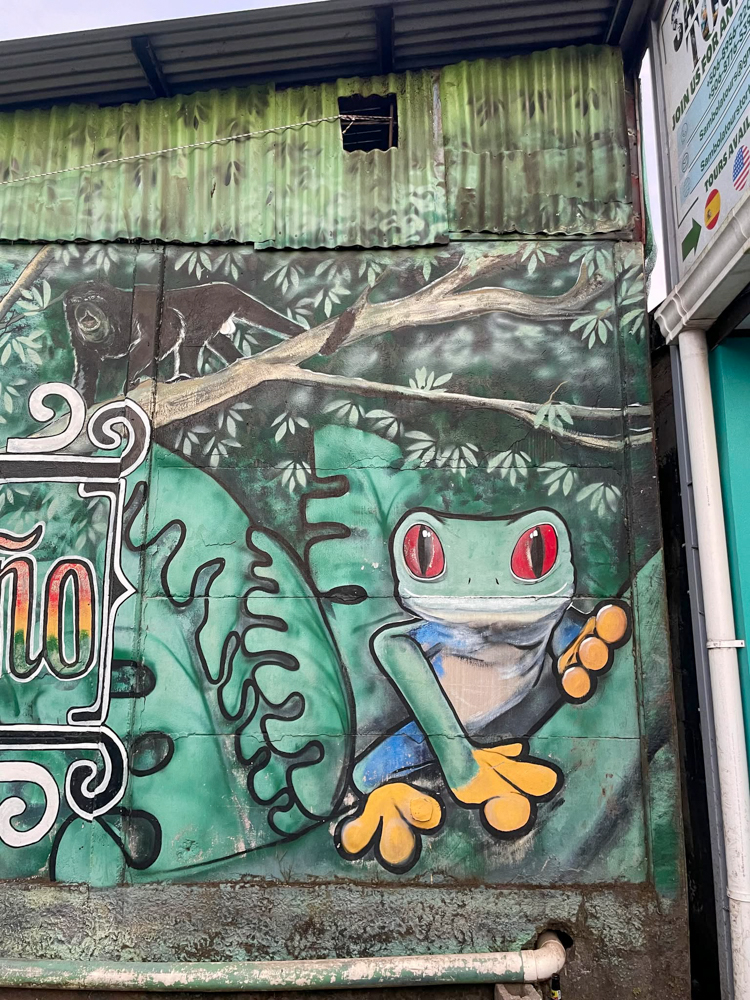
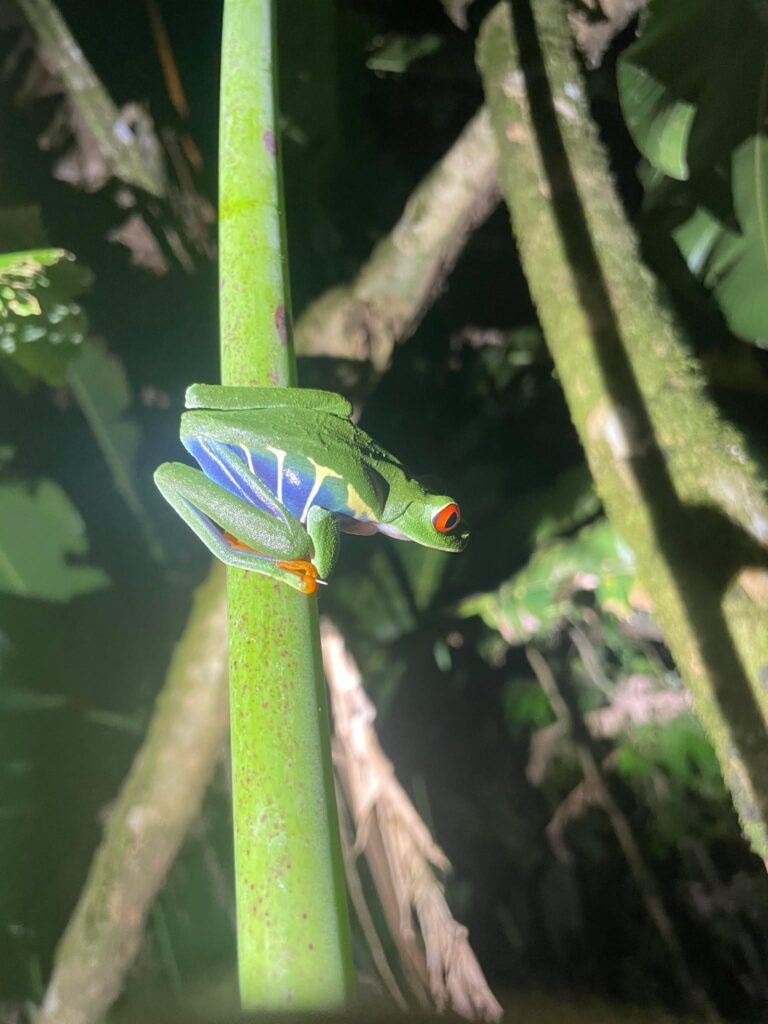
As the day quickly turned to dusk at 6:00 p.m. sharp – which occurs no matter the season due to the country’s geographical location near the equator, we joined a night tour to observe creatures hidden from our untrained eyes.
Our guide spotted sloths and toucans perched high in the palm trees, brightly colored frogs and one of the world’s most poisonous spiders. We paraded around the dark jungle, learning about an ever-increasing jaguar population in the region, now entering Tortuguero by night to snack on stray dogs and cats in absence of sea turtles, which come to shore to hatch their eggs from July to October.
“If you love your dog you let it sleep inside,” our guide said. “If not, let him out.”
Day 3: Tortuguero
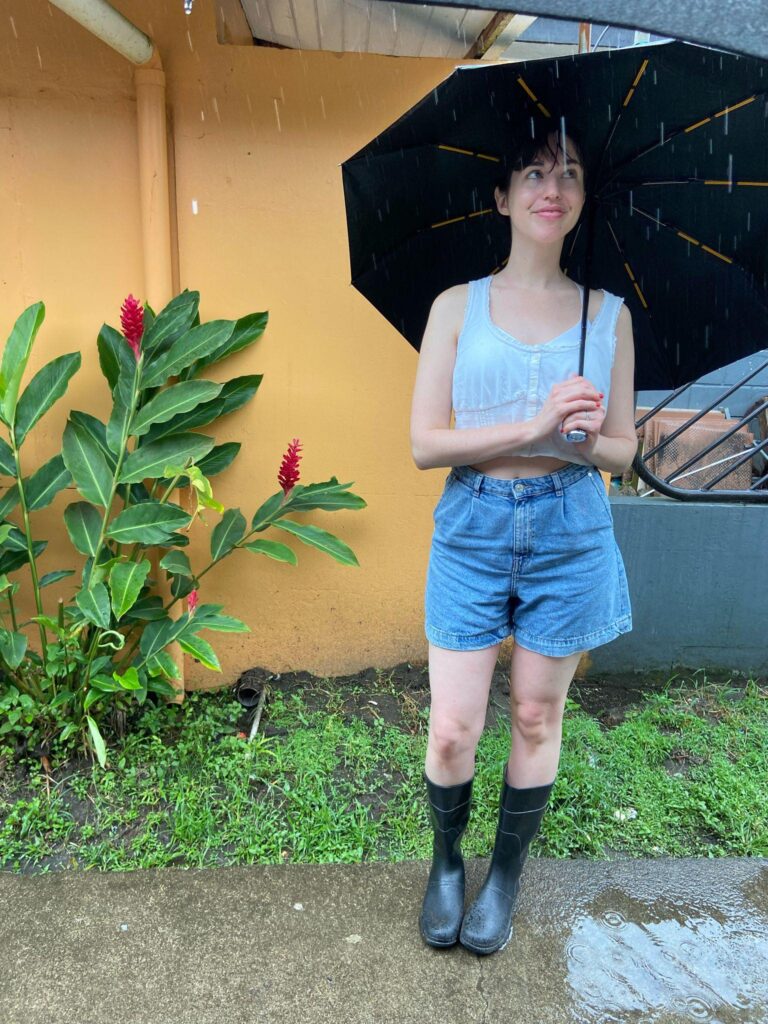
Tortugero is a small village concentrated on one main street aligned with shops selling pineapple smoothies and ponchos. We woke up at 5:00 a.m. to the sounds of a torrential rainstorm, thinking that surely our 6:00 a.m. canoe tour along the canals of Tortuguero’s national park would be cancelled.
“This is nothing,” said Carmen, receptionist at Casa Thirema. “When it really rains, this street becomes a river.”
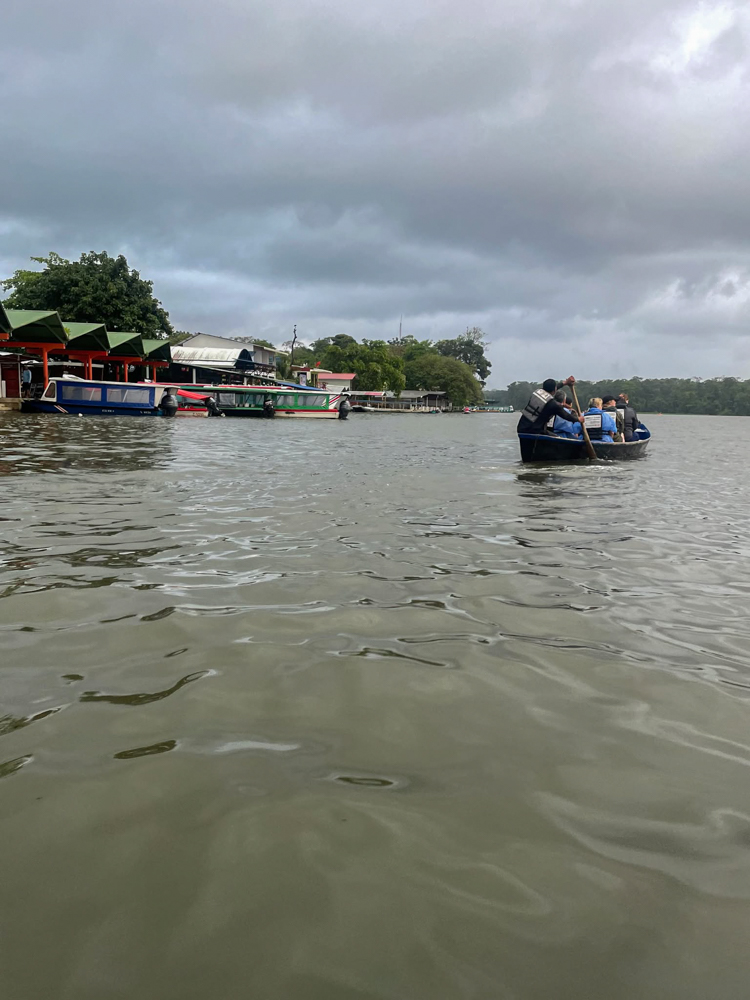
Early mornings are the best time to enjoy Costa Rican summer as this is when animals are most likely to be active and the dense humidity has not yet reached its peak, at times making afternoons difficult for those used to colder climates.
Our guide explained how certain palm leaves were cut down by indigenous communities 3 or 4 days after a full moon, believing that it helped to rid of termites and other insects. He pointed out a long-legged bird with a bright yellow beak, the jacana. Unlike the status quo, jacana females have multiple partners, with males building nests and attentively watching newborns.
“The jacana male…he isn’t you know like the Latino dad whose never there,” our guide said.
Days 4, 5 & 6: La Fortuna

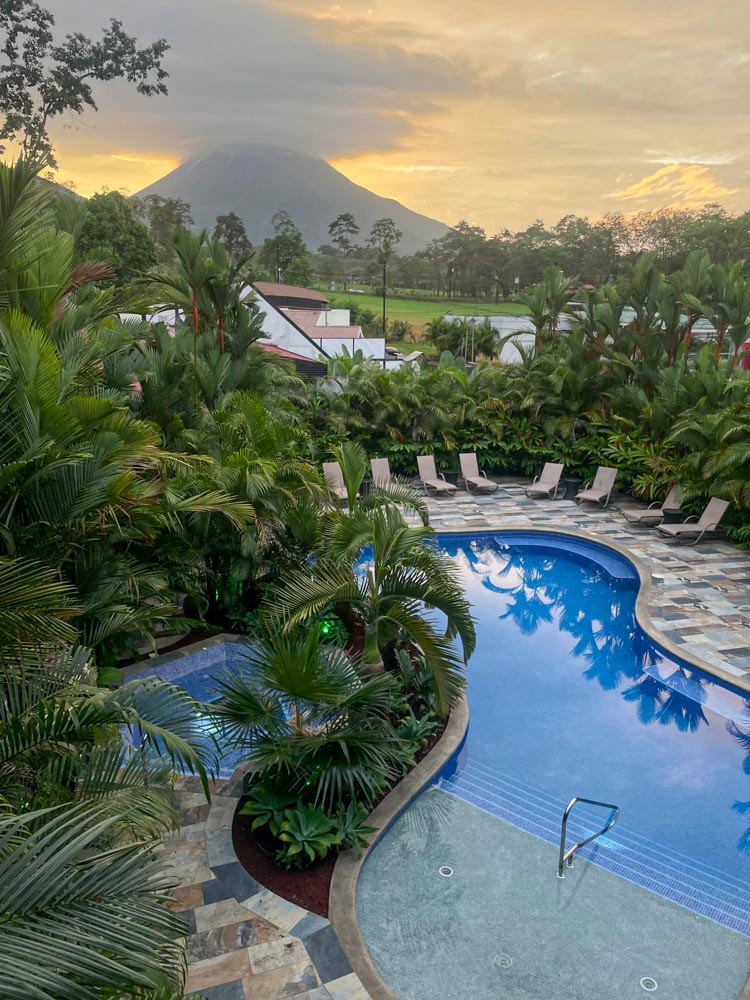
“Do you see the man lying down sleeping?” our taxi driver asked, pointing to the Arenal volcano, last erupted in 1968, covering nearby villages in ash and claiming 87 lives. In a resting phase since 2010, the clouds seemed to hover just enough above a crevice, appearing as a breath of air, or a man soundly snoring.
The volcano is striking from the village of La Fortuna, with a road aligned with shops and restaurants drawing the eye up towards the monumental site, appearing as if we traveled to the Age of Dinosaurs.
We were pleasantly surprised at our accommodation at the Casa del Rio, a luxury hotel that we initially thought was an Airbnb. The hotel is well secured, with each room given a direct WhatsApp group to write any burning questions to available staff. We particularly enjoyed the surrounding plants rich with wildlife. One of the highlights of our trip was witnessing newborn hummingbirds and a protective mother in a tree planted near our room.

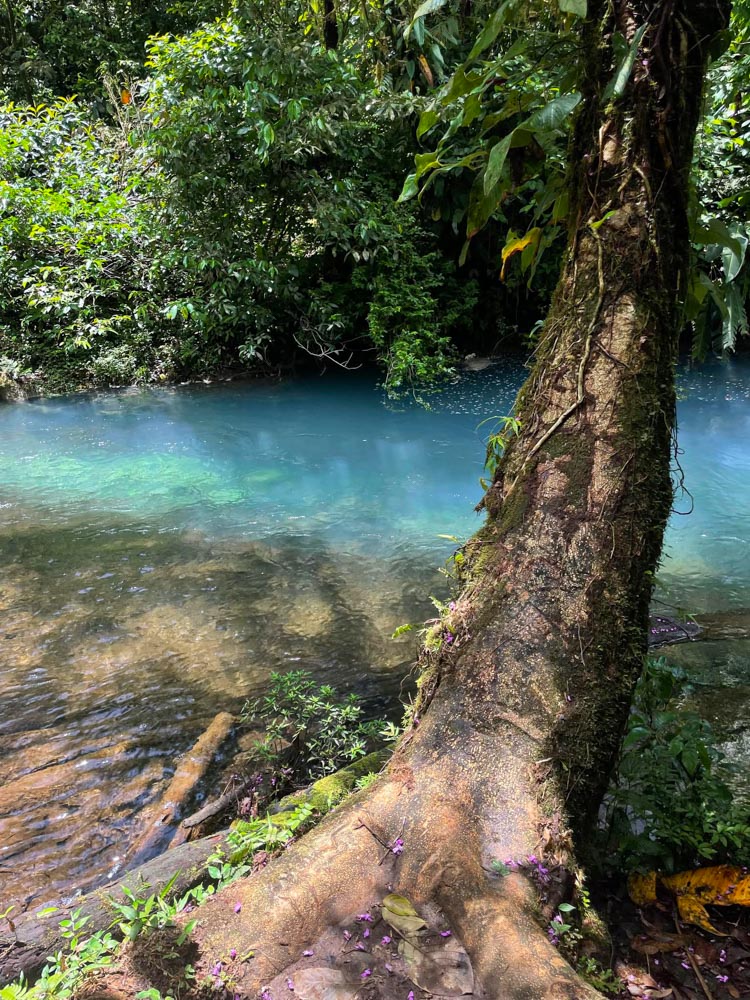
While we did not hike the trails surrounding the volcano, we did sign up for a group excursion to Rio Celeste and explored the hanging bridges at Mistico Park.
Rio Celeste is a bright blue river and waterfall located in Tenorio Volcano National Park, about an hour and a half drive from La Fortuna. Some research suggests that the bright blue hues are in fact an optical illusion to our eyes, with a mineral unable to absorb blue, thus reflecting it towards the sunlight. The trails cover approximately 5.4 km (3.4 miles), full of tourists, both children and elderly alike. While some guides made noises to attract frogs and monkeys, ours was a bit more bitter, as his ex-girlfriend was now his boss, working on the same day as our visit.
“How do you say ‘snake’ in Spanish?” piped a young woman in our group.
“Las mujeres,” our guide grumbled.

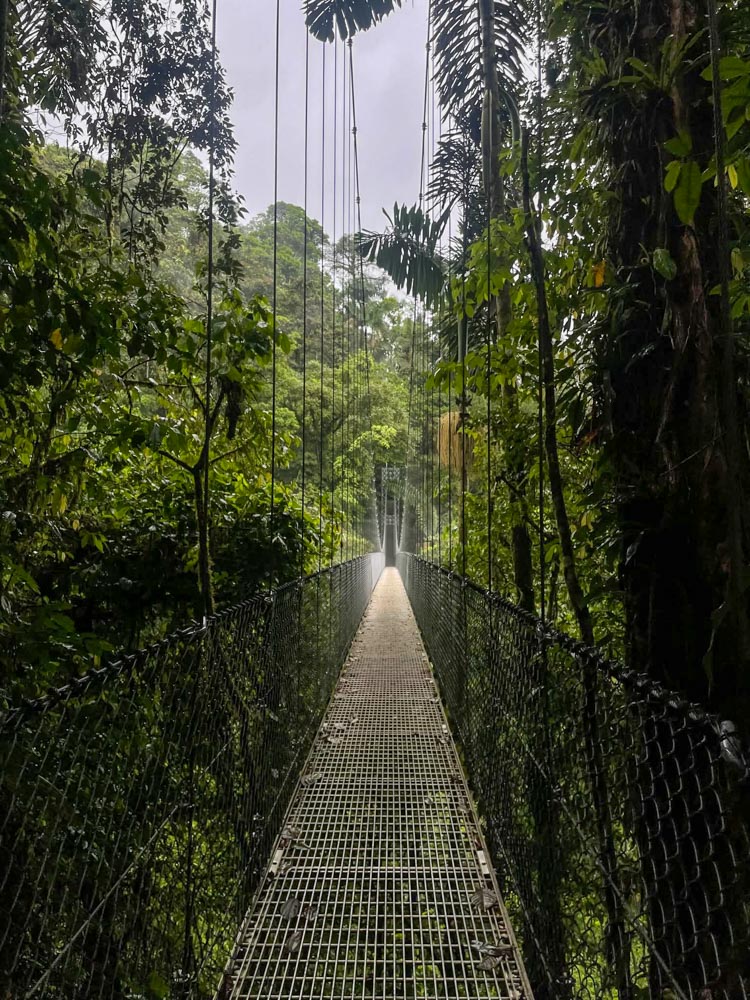
By contrast, our guide Brando (tour booked here) at Mistico Park was a professional photographer with a passion for wildlife. His enthusiasm spanned from ginger-related plants to the tiniest ants carrying leaves across the ground.
“Each ant has the strength of Hercules, comparable to us carrying 20 cars,” he chimed.
As some of the group had cancelled, our walk across the hanging bridges was a private tour. We saw both howler and spider monkeys, making the experience one of the highlights of our stay in Costa Rica. Furthermore, guides throughout the park carry telescopes, allowing you to take photos with your camera through their professional lens.
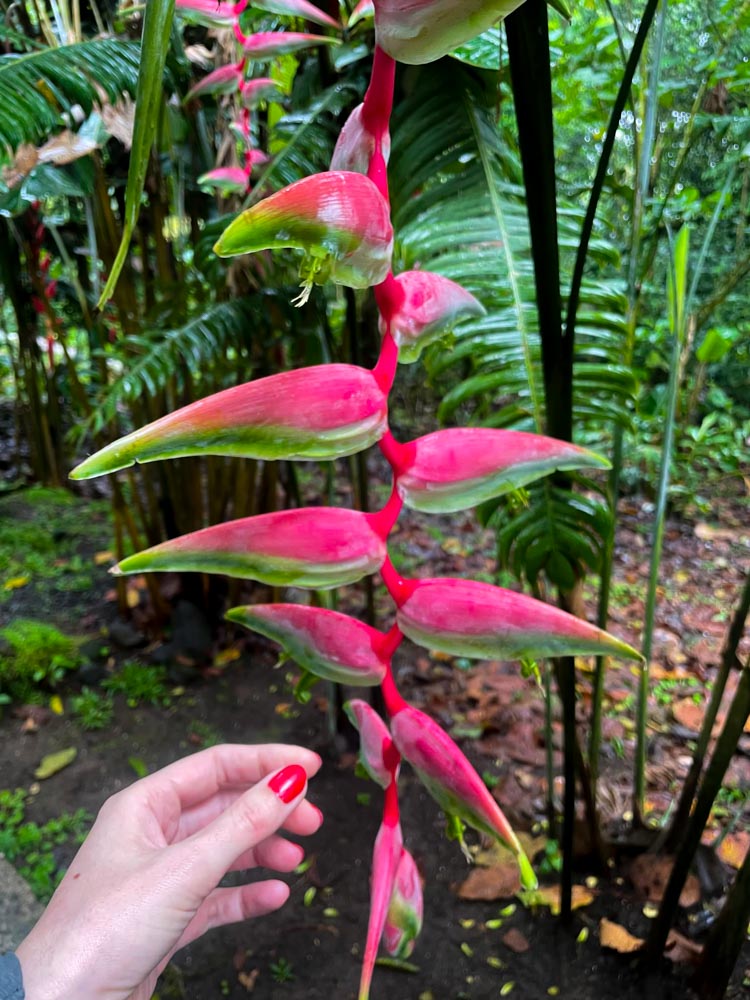
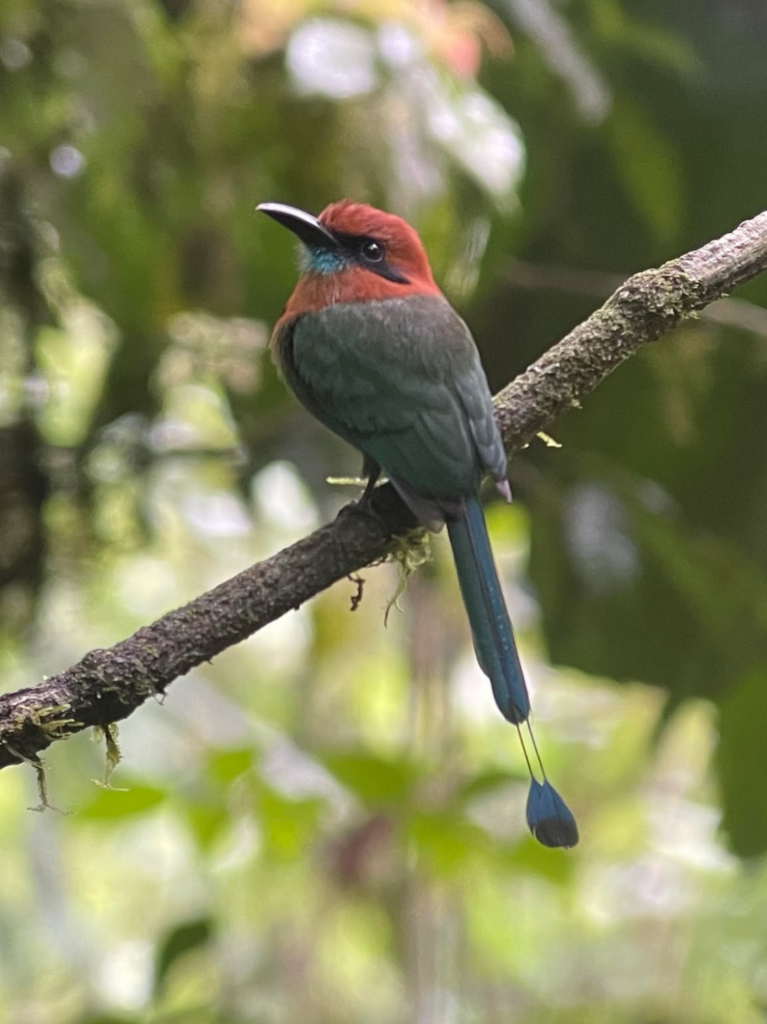
Days 7 & 8: Monteverde
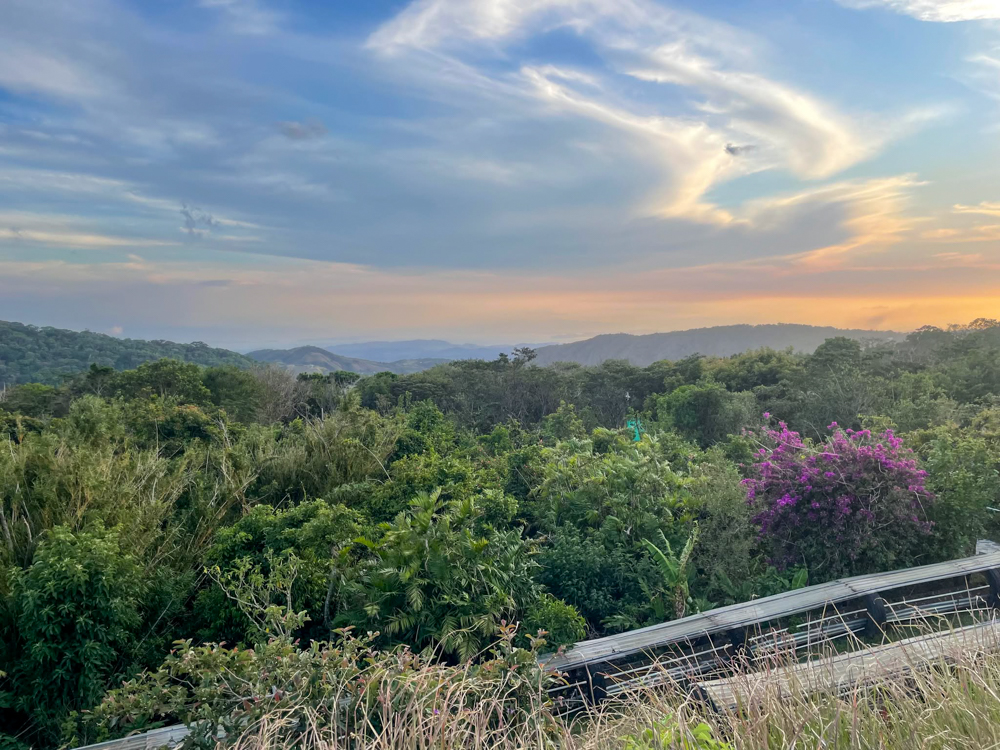
Located 100 km from La Fortuna, the journey that would have been one-hour by vehicle in Switzerland took us approximately three due to an impressive terrain. At steep inclines followed by highly suspended descents, the road to Monteverde was unlike any other I had previously experienced. Prior to traveling, other bloggers had suggested bringing medicine to combat nausea.
Halfway to Monteverde, the smooth pavement suddenly turned to country road gravel and potholes (mind you, this was the only stretch of road we encountered that was rocky during our journey). Passing vehicles were soon outnumbered by ATVs and motorbikes. Our eagerness to see Monteverde outweighed our motion sickness.
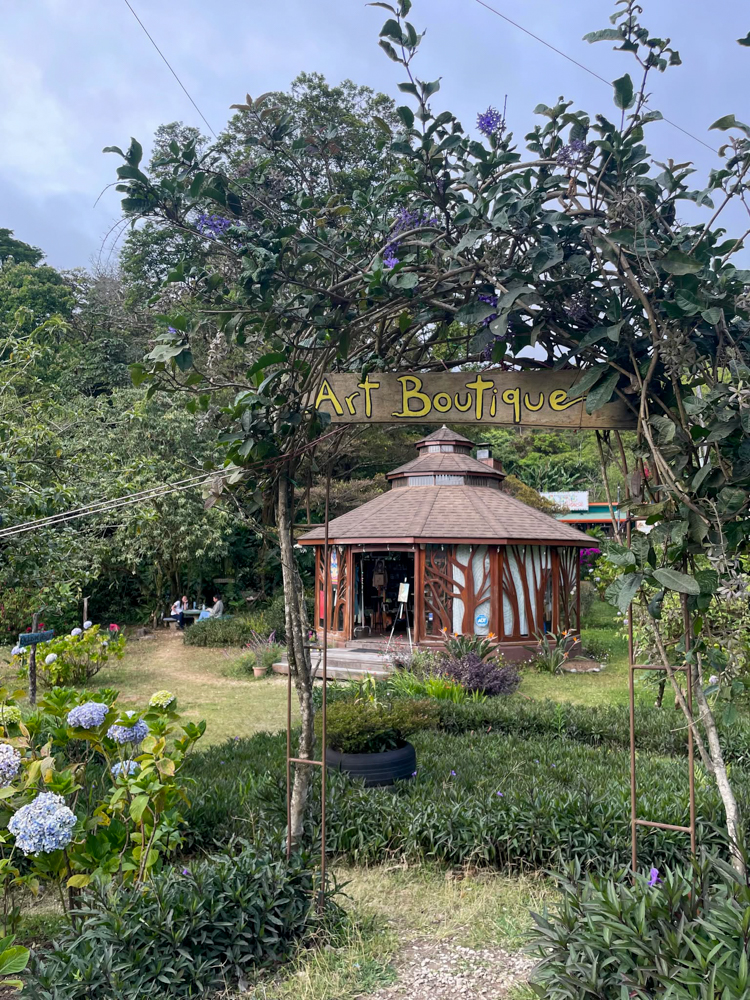
Looking out the window to the valley below, we saw Zebus, white cattle with a humped back and droopy ears, and nearby birds following their every movement to swoop in and snack on surrounding insects. Vibrant magenta, orange and teal green homes stood amid suspended wire cables, broken vehicles and discarded washing machines. The lush jungle surroundings was home to many stray dogs and cats, resembling a perfectly pieced together collage.
Monteverde is as bit how I imagine San Francisco (mind you, I have not yet traveled to California). The village of nearly 6,000 is uphill and filled with shops and restaurants promoting organic coffee and vegan products. Twenty-somethings in long skirts and baggy yoga pants shop for art crafted by local artists.
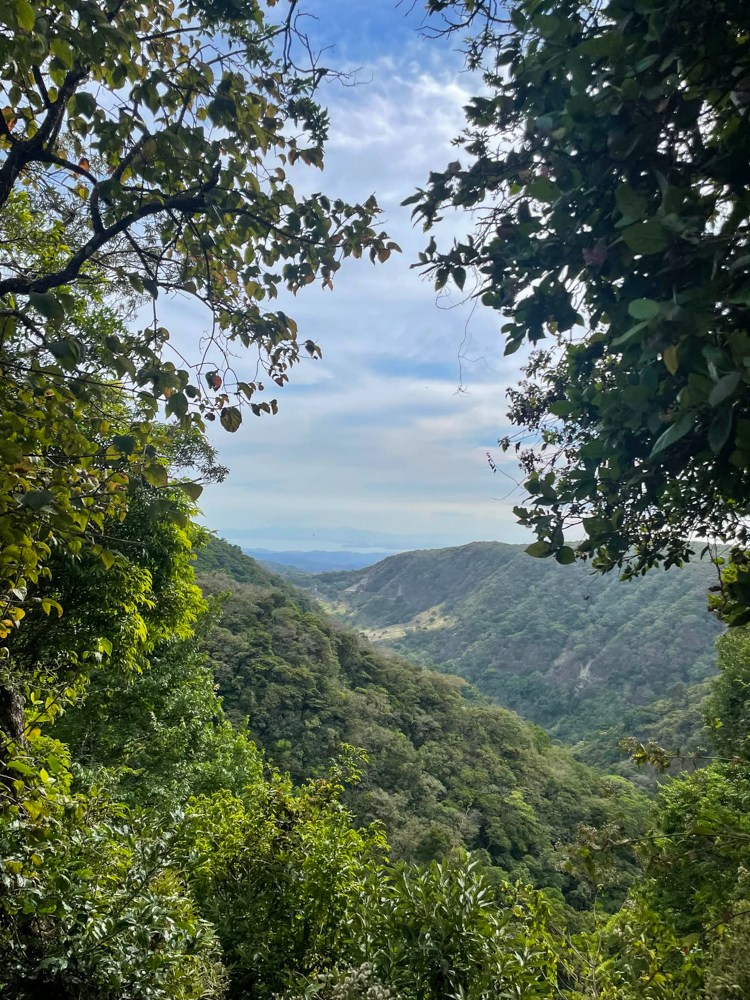
The sounds of cicadas and birds singing in the overhanging fig trees put my mind at ease – forgetting, albeit briefly, the sorrows of the world and the piles of unanswered emails back home. This sensation of calm of further cultivated at our hotel for the evening – the Valle Escondido Reserve, a hotel and farm that that practices permaculture, a philosophy of working with nature rather than against.
Valle Escondido has three greenhouses that cultivate plants and protects them from 34,000 different types of insects that call Costa Rica home. Plants and herbs from the garden are used in the hotel’s farm-to-table restaurant, one of my favorite dining experiences throughout our trip. The property is surrounded by nature trails with pathways leading to waterfalls and ponds used for breeding tilapia.
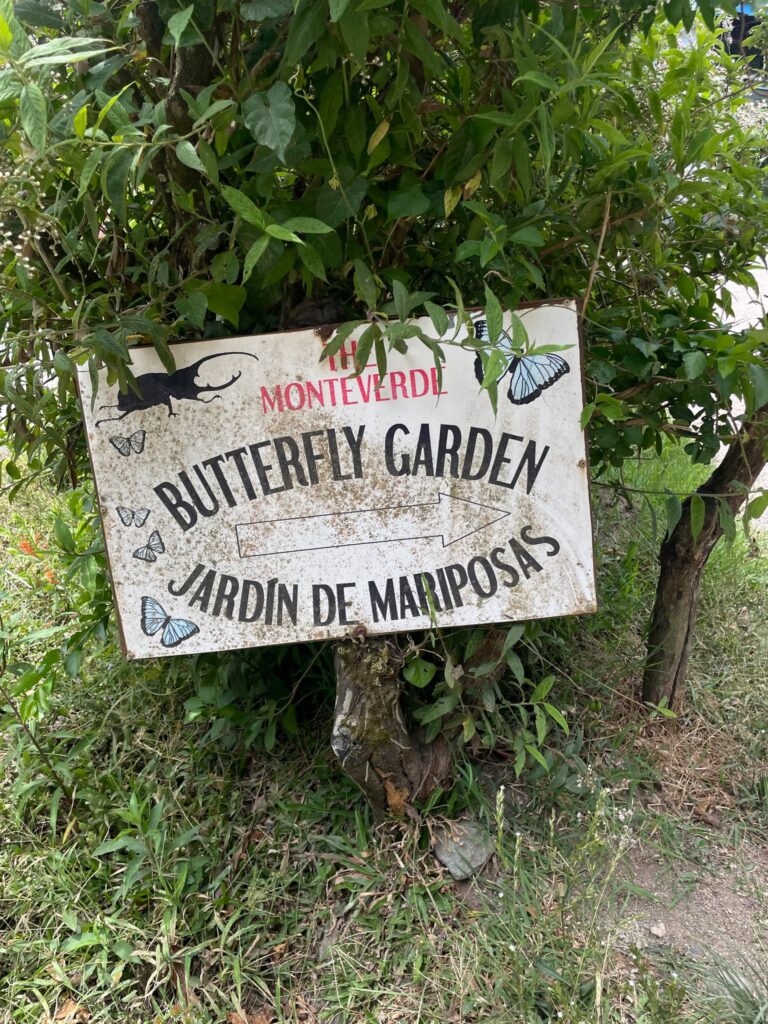
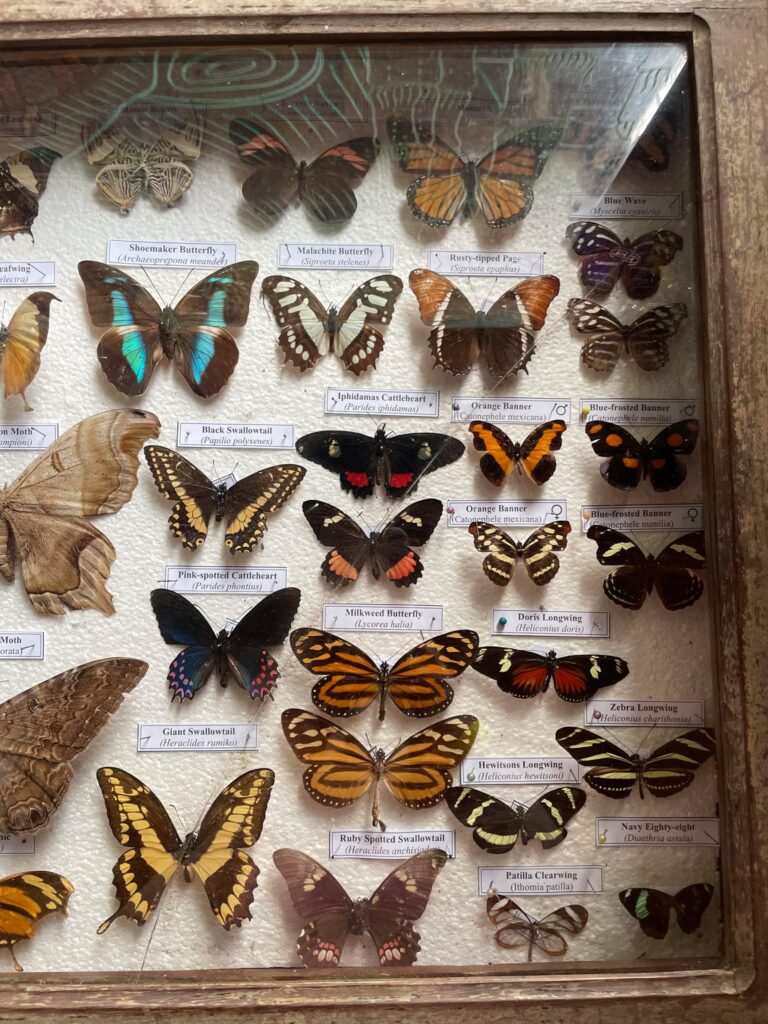
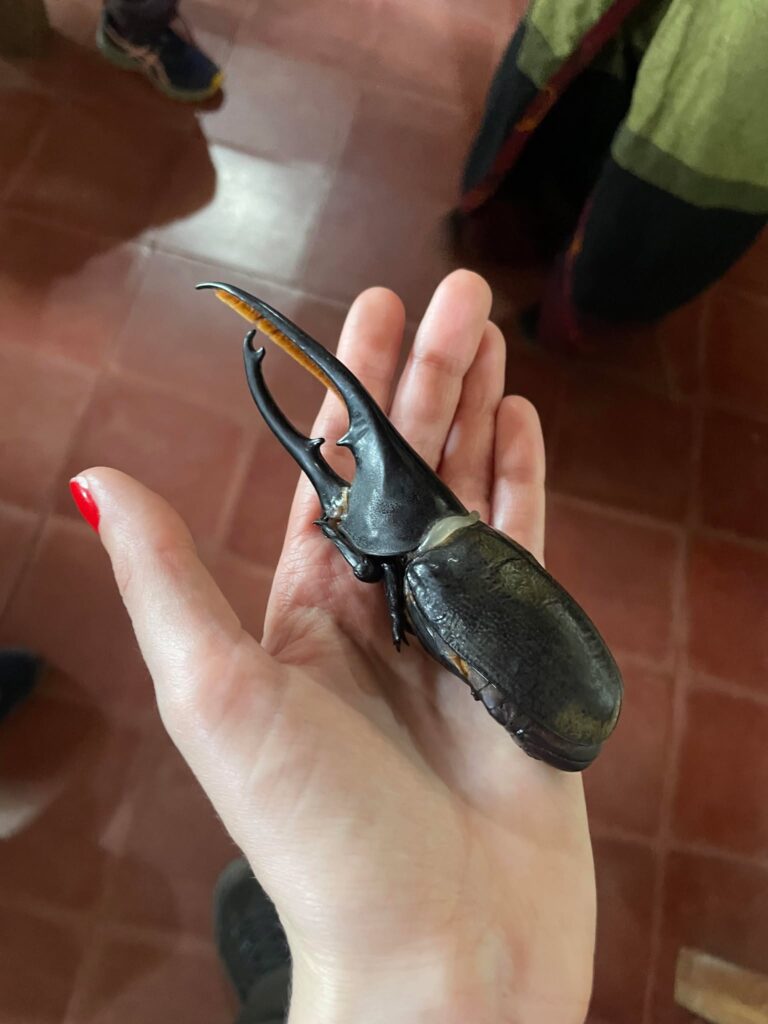
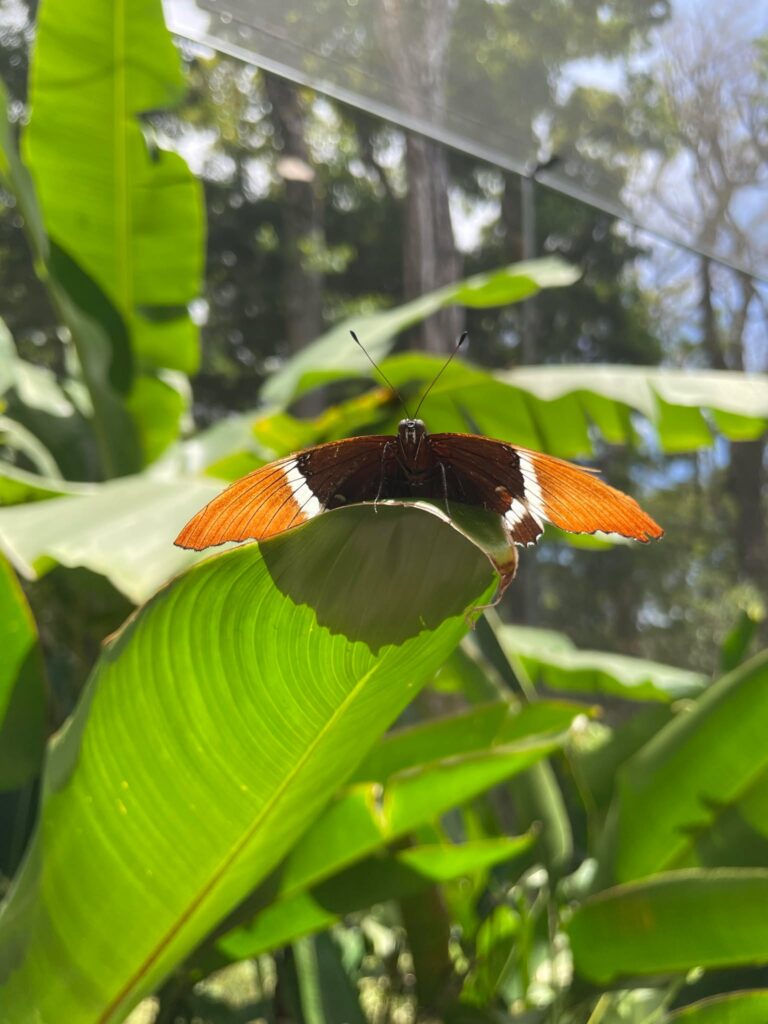

Guests can also find Monteverde’s butterfly garden a few steps away. While the US$ 20.00 entrance fee may seem expensive, it comes with a tour. Our guide began by discussing hissing cockroaches, and sharing the garden’s star cockroach, Timmy. She was talented in that by the end of our visit, we had sympathy for cockroaches, scorpions and tarantulas, rather than feeling disgusted. She shared that cockroaches, unlike butterflies, clean themselves nearly 100 times per day, and can even detect smells of those who are familiar to them and the unknown.
“When I turn my pet cockroach at home on her back and pet her belly, she doesn’t even hiss at me anymore,” our guide proudly said.
Love really is, all around.
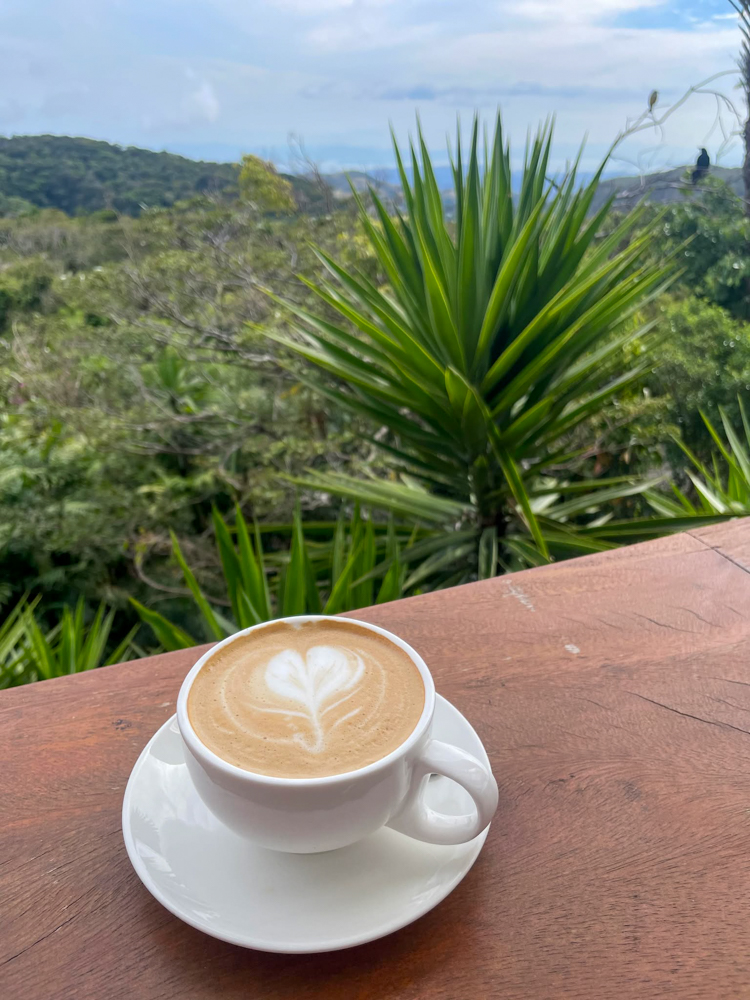
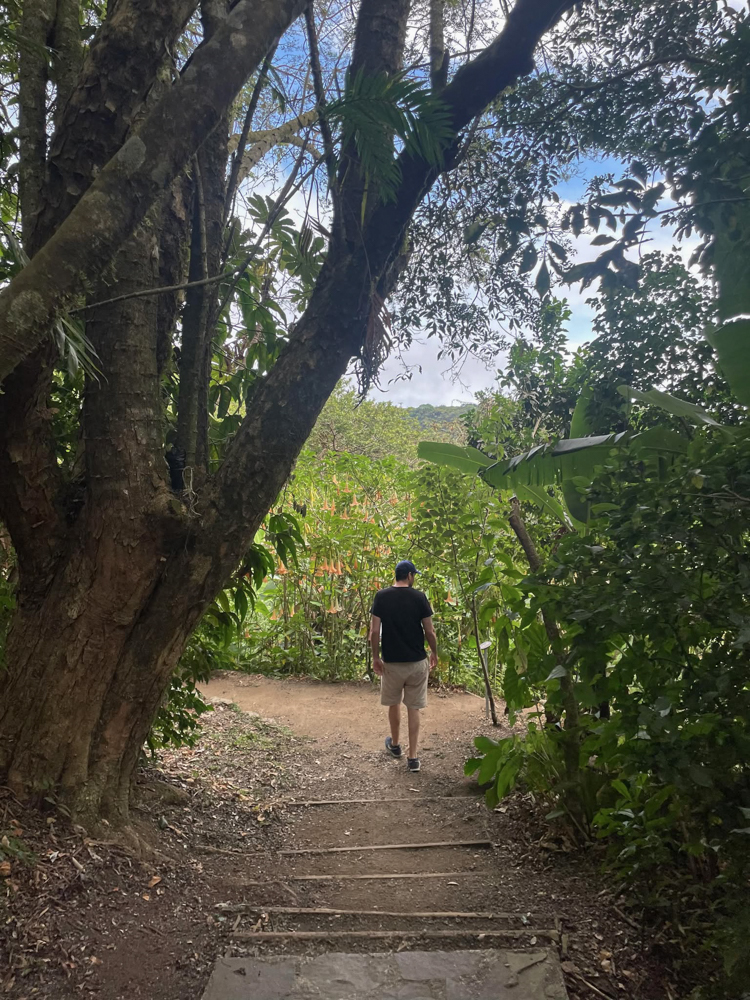
Before setting out to the Pacific Coast, we tried one of Costa Rica’s more adventurous activities: ziplining at Aventura Adventure Park, boasting Latin America’s longest zipline in Latin America at 1590 m (5220 ft) above the cloud forest.
“Wow, it feels like we’re in the opening scene of Cliffhanger!” Laurent said excitedly.
Aventura Park covers eight different ziplines, beginning from smallest to largest, and concluding with its legendary Tarzan Swing. A demonstration is shared ahead of accessing the ziplines, and several team members complete checks of each zipline beforehand, ensuring that every lock is secured.
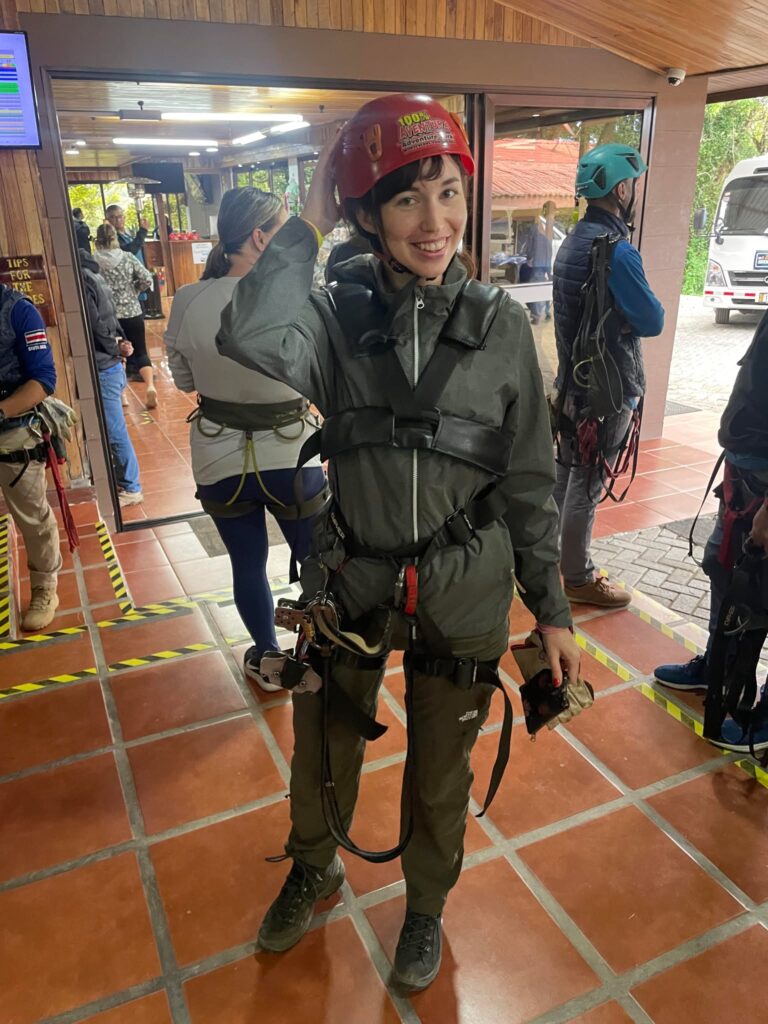
The last two ziplines have the option of taking a superman position – arms outstretched, taking in the canopy forest below, flying like a bird, however, not having the option to choose where to fly. Those with head, shoulder or back pain are discouraged from transforming into superman. As someone with frequent neck pain, Aventura made an exception for myself, which seemed to set the staff member fastening me to the zipline off guard.
“Ah…you’re not doing the superman? It’s just that…well, you could risk getting stuck in the middle of the line as you need weight to push yourself forward.”
“…come again? In that case I may not do this,” I nervously replied.
I felt a sudden push and began flying across the line. Afraid of planes, ski lifts and hot air balloons, my irrational fear of falling faired no differently when faced with ziplines. Taking short breaths, I slowly opened my eyes to the wilderness below – a view so beautiful that my fear was temporarily transformed into a feeling of enchantment.
Days 9 & 10: Sámara
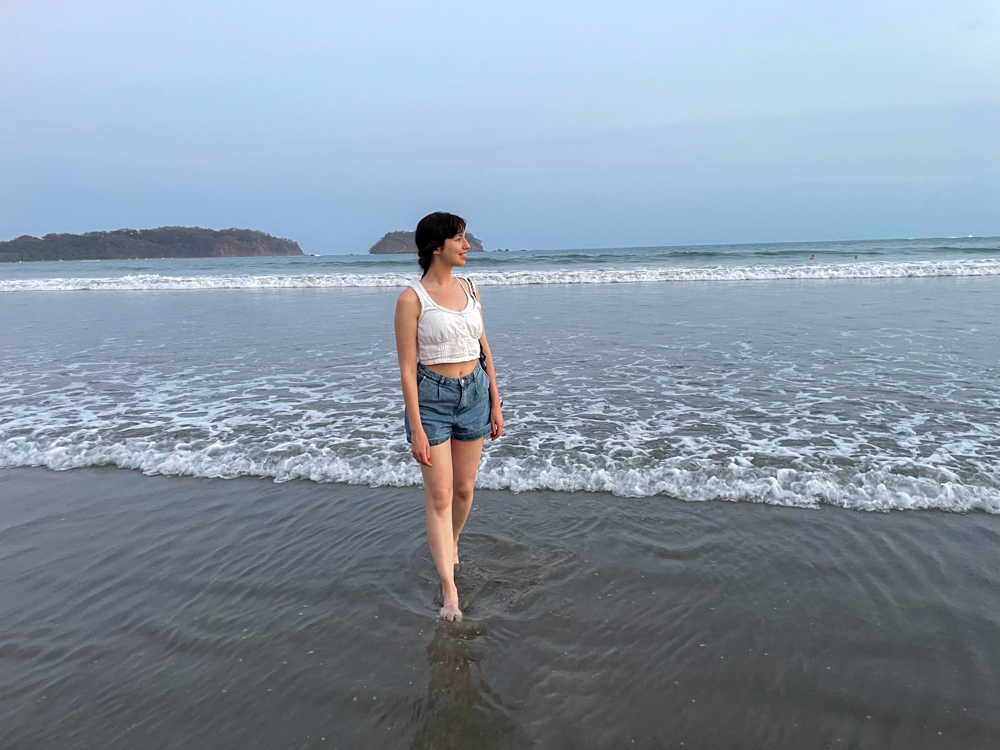
We heard of Sámara from friends who grew up in Costa Rica and frequently travel back. We didn’t expect to do much else other then, in the words of Ken in the Barbie film, “beach”. Although there are plenty of activities on offer in this quiet village, we’d already done our fair share of night walks in the forest, boat rides on mangrove-studded waterways and felt too sorry for the scrawny horses to try horseback riding on the beach.
We stayed at Bahia Hotel & Restaurant, which is conveniently located directly on the beach, where guests can eat breakfast outside sitting with bare feet in the sand. The receptionist suggested driving 10 minutes further to Playa Carrillo, to avoid tourists and overpriced chairs.

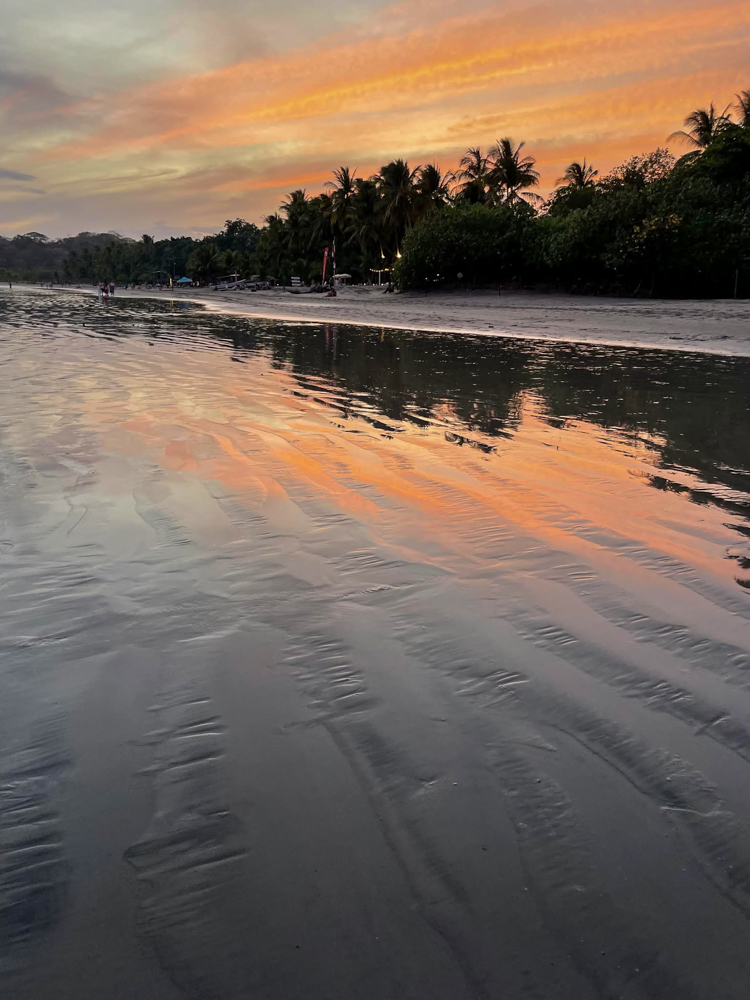
After a day of beaching at Playa Carrillo, we hailed a cab to return to Sámara during high tide. As we waited along the road stands selling fresh coconut water, we noticed a junction where an estuary met the Pacific Ocean. Children waded in the water nearby large signs noting to “beware of crocodiles”, and police officers patiently on standby.
“This water is great for crocodiles” our taxi driver said, pointing out the high tide. He shared that there were 11 crocodiles in the area, two of which were about three meters long. Unlike the American crocodile, the local breed only swims in freshwater, and does not hunt for hunting’s sake.
“The American crocodile? He sees me. He swims. He hunts me. No more driver.”
Days 11 & 12: Cabuya – Montezuma
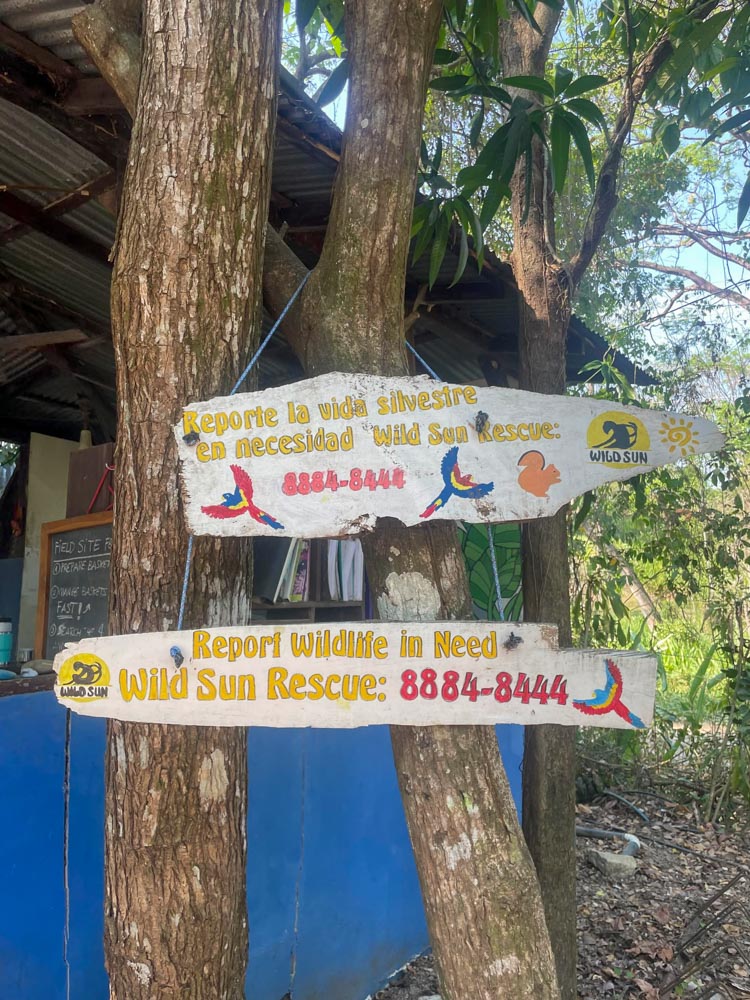
Montezuma is a small village along Costa Rica’s Pacific coast that attracts long-haired surfers and vegans. Shops smell of incense and have several posters of Krishna.
We stayed in at the Wild Sun Rescue Center in Cabuya, located approximately 8 km from Montezuma. This nonprofit organization is comprised of several volunteer veterinarians who strive to rescue, rehabilitate and release wildlife into their natural environment. Proceeds from its hotel go to medical procedures for wildlife and the projects that ensure their protection.
During our stay, we were greeted in the morning by large iguanas, agoutis in the nearby bushes, or large rodents native to Central America, and scarlet macaws flying overhead, and could see howler monkeys swinging on the trees from our bedroom window. On the day of our arrival, a boa constrictor was brought in, who had survived cuts from a machete. Wild Sun also receives many howler monkeys, who often confuse wire cables for vines.
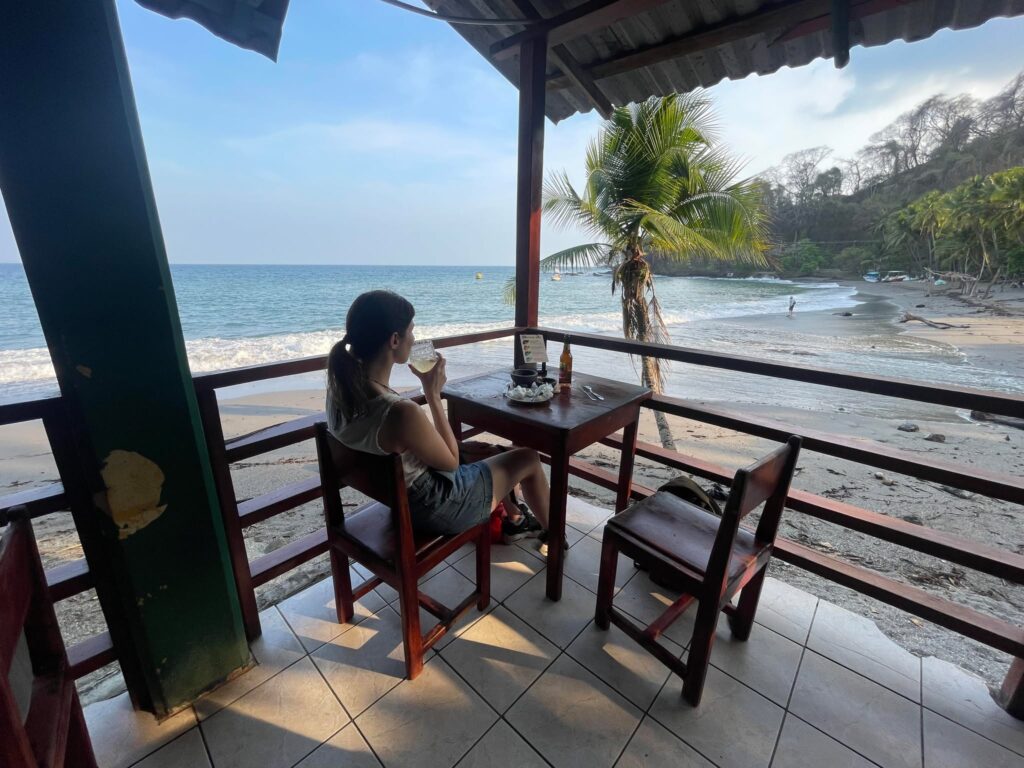
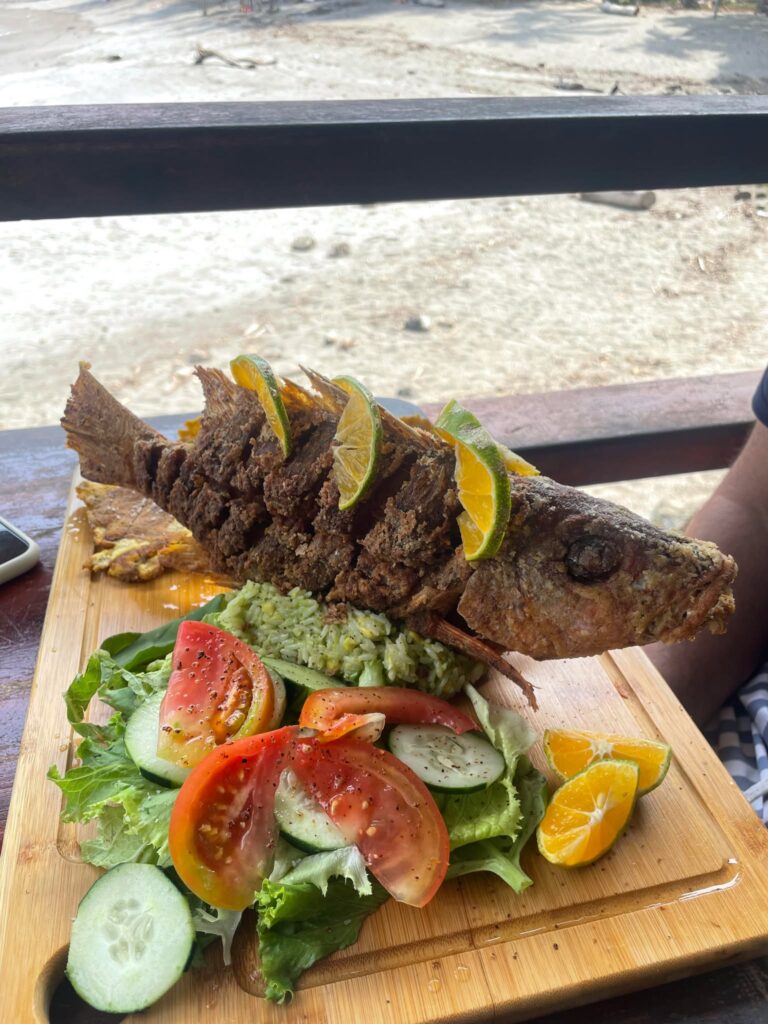
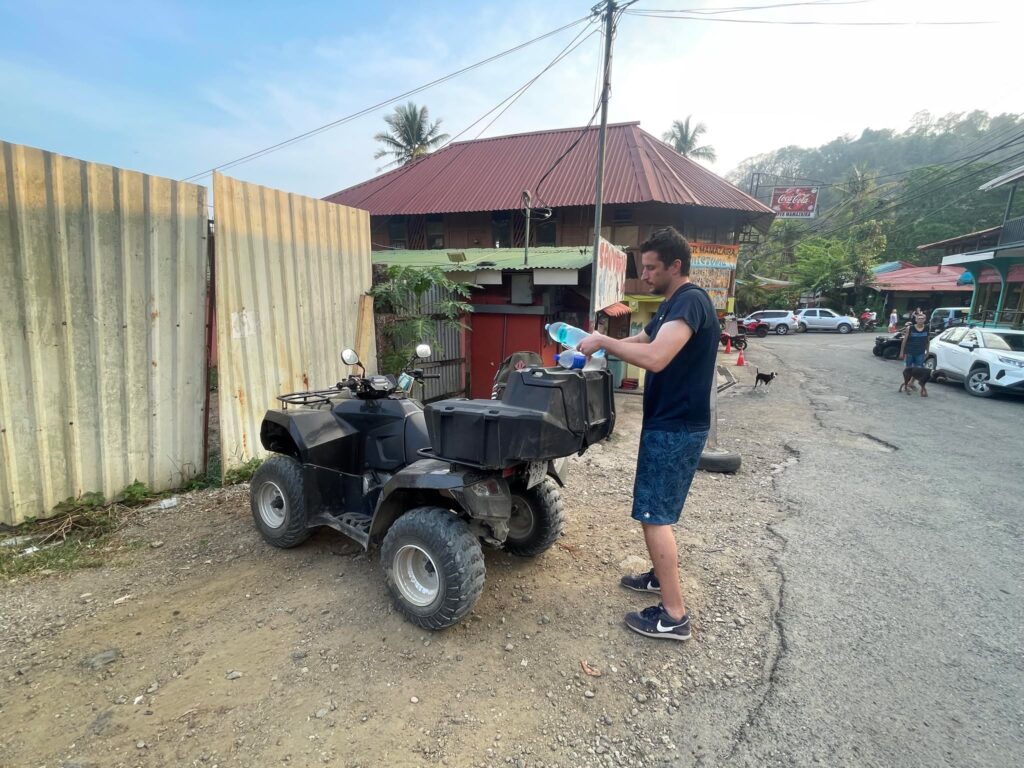
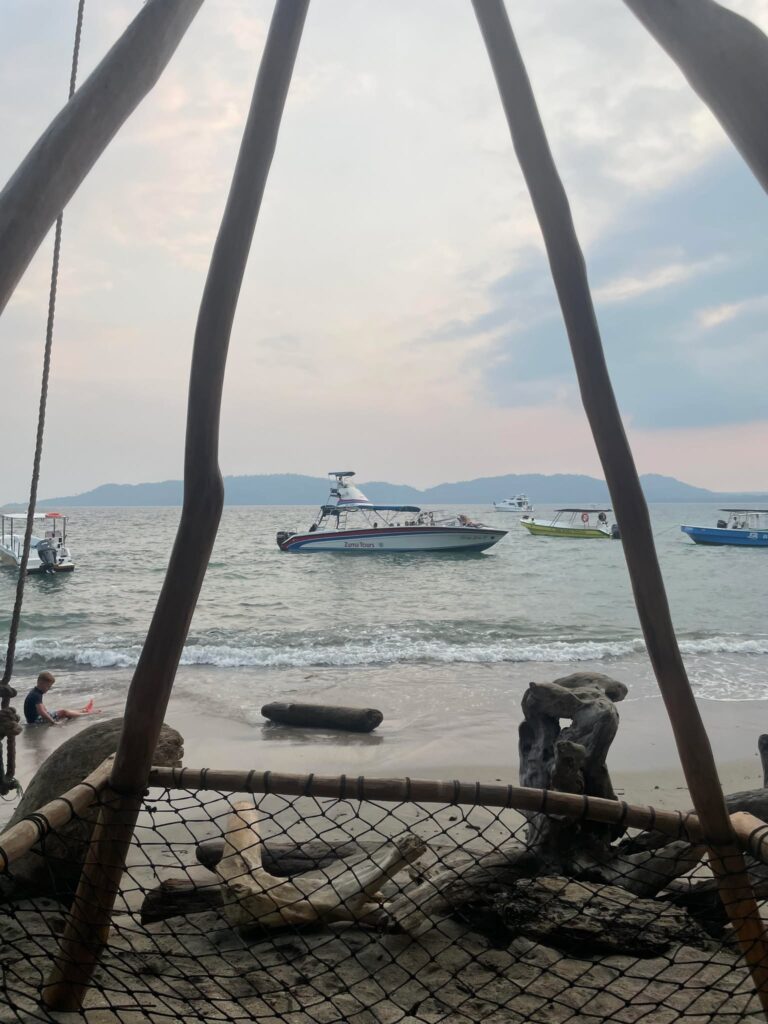
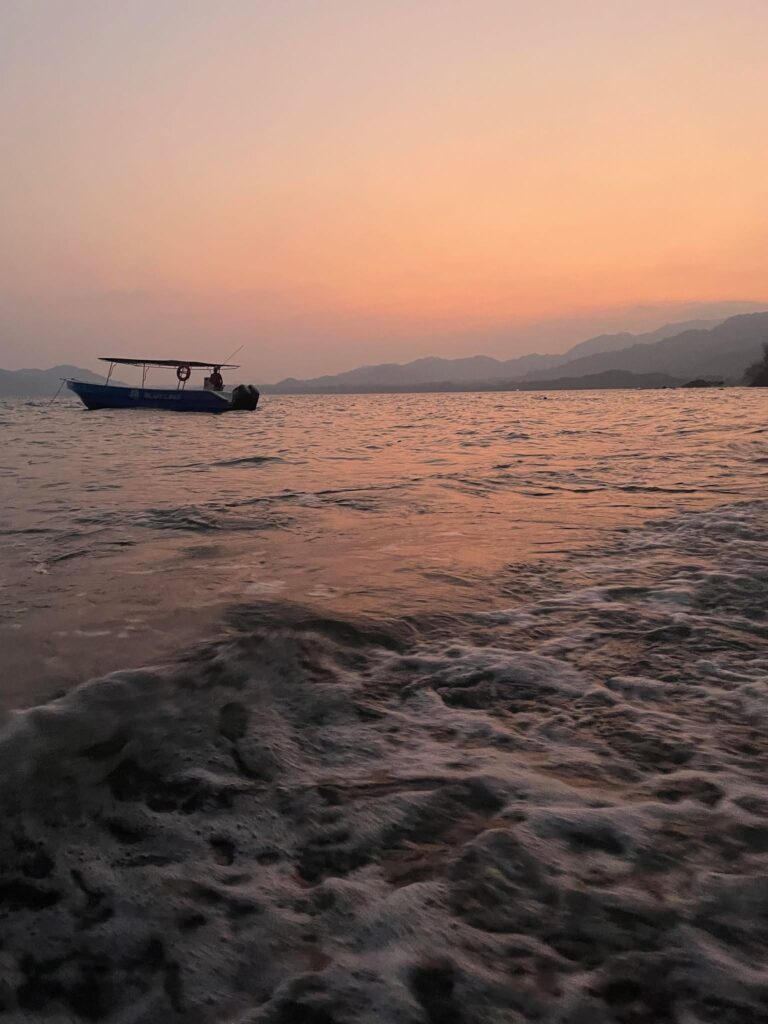
In order to travel between Cabuya and Montezuma, we rented an ATV, proving useful along the bumpy terrain. The short route to Montezuma overlooks the rough currents of the Pacific Ocean and is aligned by Ceiba trees, sacred to the Maya who believed that they served as a portal from this world to the next.
“Just make sure to watch out for monkeys jumping onto you from the trees when you drive,” the ATV shop owner said to us on our way out.
We laughed, not fully certain whether he was joking or not.
Day 13: Manuel Antonio
Perhaps it was due to fatigue, or the fact that we dearly missed our cat at the end of two weeks. Despite its white sandy beaches and Cote d’Azur-esque views, Manuel Antonio was our least favorite stop while exploring Costa Rica. Despite this, we met with other tourists who had made Manuel Antonio a home away from home, returning every few years. Other blogs I’ve come across online have also raved about Manuel Antonio. If residential areas aren’t your thing, I’d suggest staying in Manuel Antonio. However if we were to go again, I would reserve accommodation at a nearby village, Quepos, which appeared a bit more local.
The village felt constructed for tourists, comprised of hotels surround the Manuel Antonio National Park. While not the largest national park in Costa Rica, its dense jungle and proximity to the sea make it a hotbed for diverse wildlife. Once again we decided to be led through the park by a guide, whose soft voice was often overrun by herds of tourists at 7:30 a.m., taking away part of the charm of what I imagine is a truly magical place.
We were grateful to learn towards the end of our trip about Costa Rica’s 24 vipers, 17 of which are venomous. Approximately 400 snake bite cases occur per year throughout the country, or at least one per day, often when snakes are walked upon. If bitten by a poisonous viper, the victim has one-hour to get an injection from the hospital. A viper bite will melt muscles, to the point where bone is exposed.
Day 14: Return to San José
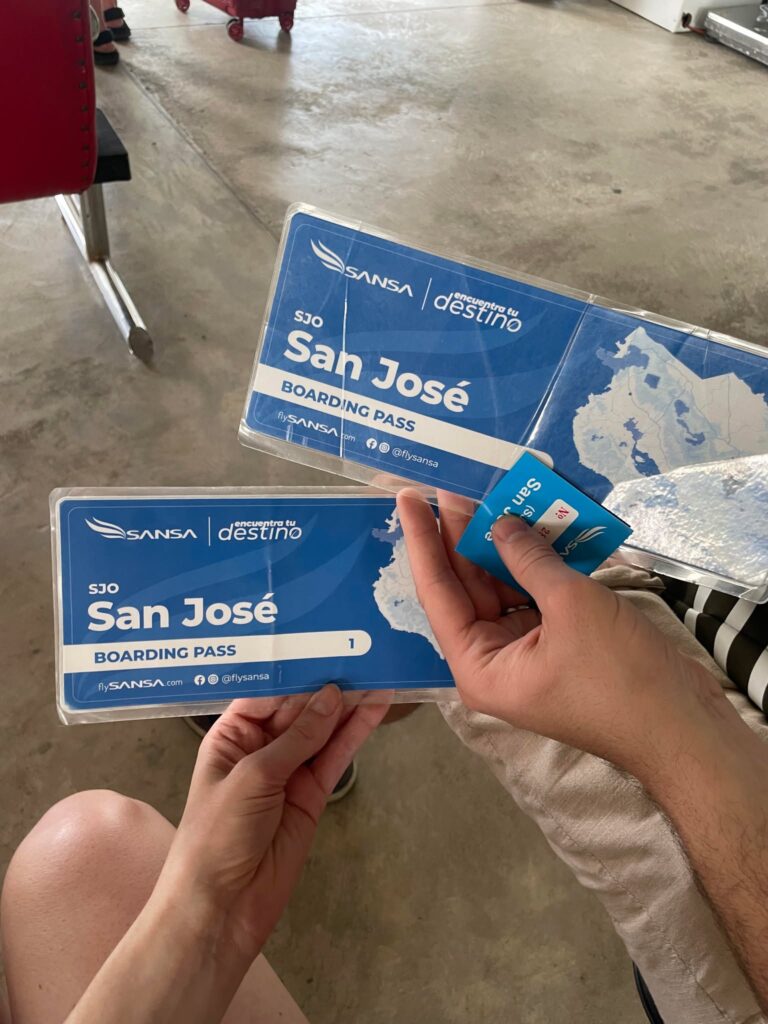
We returned to San José via Costa Rican regional airline Sansa, a small plane in which we were weighed ahead of time along with our luggage to verify that we could board. Our boarding passes were laminated and dutifully returned to the captain while boarding. The airport consisted of a garage with several small fans circulating hot air, while iguanas inched their way across the lawn. As we took off down the runway, the pilot kept his arm out the window, double checking his Ray-Ban sunglasses in his reflection.

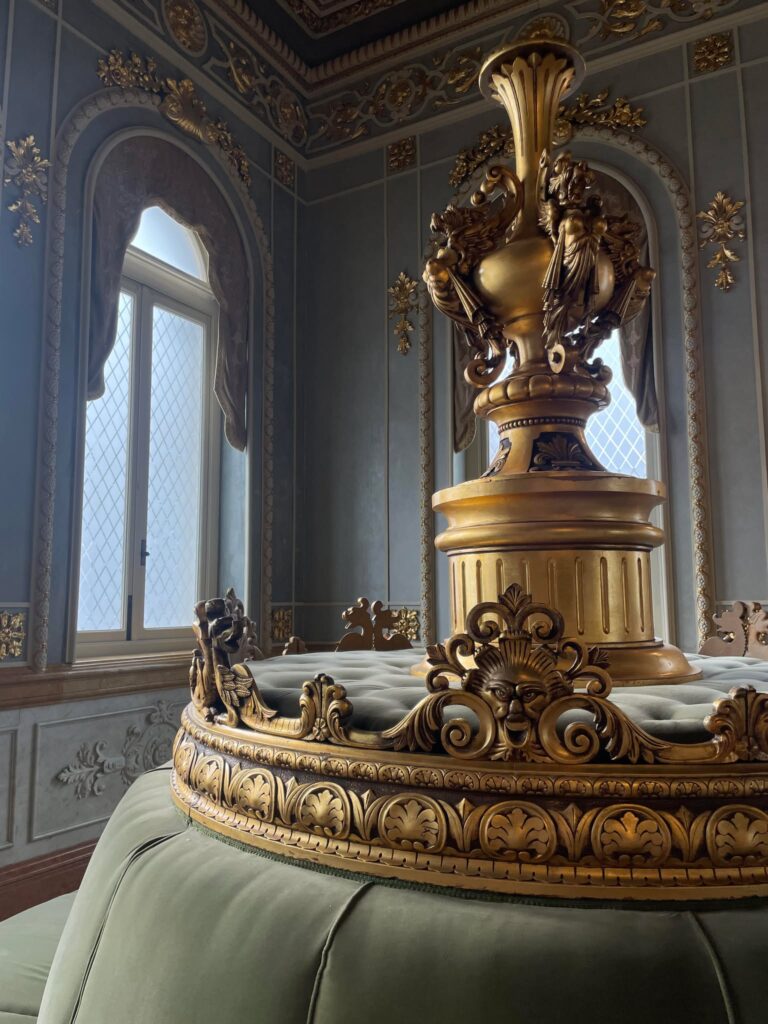
Arriving in San José was a cultural shock compared to the previous days of tranquility in the jungle. Each store had an MC blasting different styles of music, primarily Reggaeton, promoting prices on shoes (and there are so many shoe stores), clothing and electronic gadgets. The street smelled of fried food, with crowds walking in every direction, like a bustling Moroccan souk.
There are some sights to take in if staying in San José, such as the National Theater and National Museum, which we visited. A large museum on Jade and another on gold is also in the area. Our general consensus is that the beauty of Costa Rica is best viewed when traveling outside of the capital.

Loved this article! I felt like was right there with you! What a beautiful place!
Reminds me of Curacao which also, the sun sets every day at 6 p.m. no matter the time of year!
I imagine that Curacao has a similar vibe! We will have to add that destination to our list!
So well written with so many interesting facts! Like if i had lived it…
Comments from secret admirer (aka my husband) are my favorite